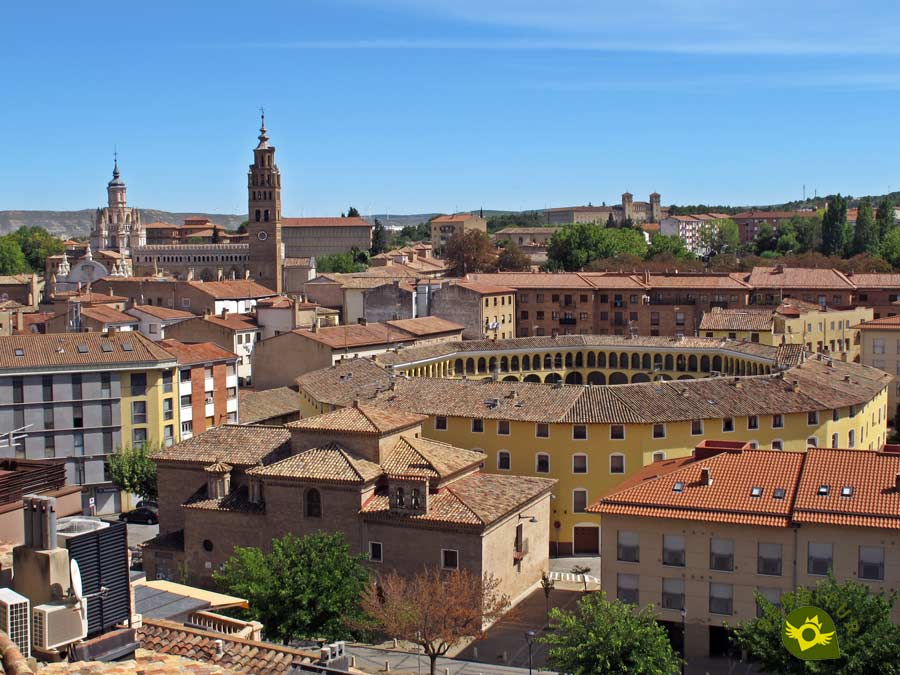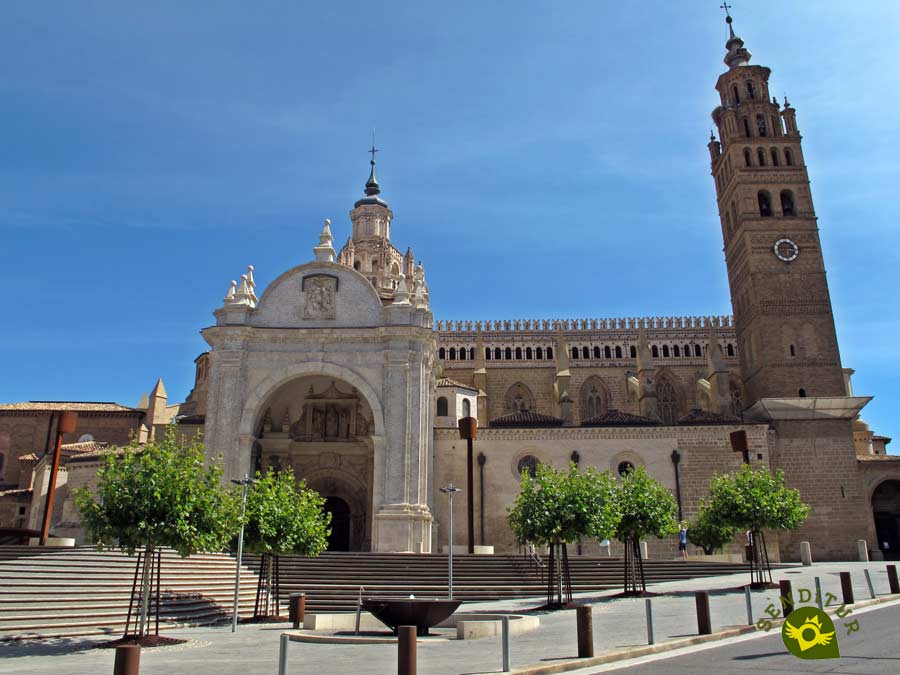Watered by the Queiles River, it sits at the foot of the imposing Mons Caunus, Moncayo, and its natural park, at the western end of the province of Zaragoza, being a crossroads between Aragón, La Rioja, Navarra and Castilla y León. In Tarazona the human settlement was very early, because the geographical conditions and the abundance of water were decisive factors for it, so much so that it became an important Celtiberian city that even had its own currency. When the Romans extended their empire throughout the area, Tarazona maintained its importance and became a Roman municipality around 30 BC. From this period comes the agate head of Augustus that is in the Archaeological Museum of Zaragoza. Tarasauna was, from the year 714, next to Tudela, a main Muslim city, but before this it already seems that there existed in the locality, from Roman times, a modest Jewish community that in the Visigothic period of the sixth and seventh centuries reactivated the trade of the city. In the 12th century, after the definitive reconquest, Alfonso I already ceded part of the tributes from the aljama to the bishopric.

Throughout the Middle Ages, Christians, Jews and Muslims lived together in the multicultural Jewish quarter of Tarazona. In the 16th and 17th centuries, with the abolition of the provincial rights of the Aragonese in the courts celebrated here by Philip II and later with the expulsion of the Moors, the area was almost depopulated and impoverished. During the War of Independence, Tarazona was occupied by Napoleon's troops. With the reform of the State in 1833, Tarazona was incorporated into the province of Zaragoza. During the first half of the 20th century, industrialization arrived in the city. The current Tarazona, displaying its rich cultural past, forms part of the European Network of International Translation Centres, and taking its inspiration from the School of Translators that existed here between the 11th and 12th centuries, and in which Arab and Hebrew translators took part who translated treatises on mathematics, astrology, alchemy or philosophy, houses the only Translator's House in Spain, a centre for creative stays by literary translators from all over the world who work with one of the official languages of Spain and any other combination of languages. The house was founded in 1988 by Francisco Uriz, winner of the National Translation Prize.

Tarazona, as Bécquer says, is a city with a genuine original, historical and artistic nature, a small Toledo, with streets with arches and altarpieces, with stone houses that have shields and coats of arms and high and laborious iron bars. The historical and artistic heritage of Tarazona is a vast legacy that over the centuries has left its history and its people. The Old Jewish Quarter, a whole network of narrow cobbled streets that maintain a marked medieval character. Streets like Judería, Aires, the Rúas Alta and Baja de Bécquer, the Square of the Arcedianos or the Square of the Mata. The Jewish quarter of Tarazona was one of the most important in Aragon and today it is part of the Network of Spanish Jewish Quarters. The river Queiles serves as a divider between the most historic redoubt, the upper part of the city, and the lower quarter where the famous octagonal bullring is located. It was built in 1792 and was a building with 32 houses whose owners rented the balconies when there were celebrations. Nowadays, people still live in their homes because the bullfighting shows are in the new bullring, built in 1870.

In this area is also the church of the Virgen del Río, from the 18th century, which houses the image of the patron saint of Tarazona. And of course and unavoidable visit the Cathedral of Nuestra Señora de la Huerta, probably built on an old Arab chapel in the mid-twelfth century. Its initial design was expanded over the following centuries, so the cloister is from the XVI. It is known as the Sistine Chapel of the Spanish Renaissance because of the unique paintings housed in the head and dome that were discovered after its extensive restoration. Close to the cathedral is the sixteenth-century palace of Eguarás, which stands out for its dimensions. From the other side of the river, the Mudejar tower of the church of Santa María Magdalena, which is the oldest preserved temple in Tarazona, draws the visitor's attention to the old quarter, the upper district of El Cinto.

The Episcopal Palace, built on the old Zuda, a Muslim fortress, where the Aragonese kings also temporarily resided; the houses hanging from the old Jewish quarter; the town hall, which was originally the 16th century Lonja; churches such as San Miguel, La Merced or San Martín; the old church of San Atilano, patron saint of the city, which tells the tradition that occupies the place where the birthplace of the saint was and which is now equipped as a cultural space; convents; palaces like Alcira, Gil de Borja, the house of Linares or the Canon, are other of the many buildings that keep years of history and occupy an important place in the visit to Tarazona. But if the historic-artistic site of the town is beautiful, no less spectacular is the natural environment in which it is located, and which offers the visitor walks, strolls and hiking trails through the Somontano meadows, the Moncayo Natural Park or the Queiles valley, which will undoubtedly be interspersed with the pilgrims who arrive in Tarazona following the Castilian-Aragonese Way of Saint James.

Tarazona celebrates its patron saint festivities in honour of San Atilano at the end of August although its festivity is on 5 October, the day on which festive events are also held to honour him. At the end of September the festivity is San Miguel and the first Sunday of July the traditional Pilgrimage of Quilay takes place, which with more than 500 years of antiquity, congregates to Turiasonenses and like not also to foreigners, in the Sanctuary of Nuestra Señora del Moncayo. The Virgin of the River is the patron saint of Tarazona and its festivity is celebrated on November 7.
Every year on August 27th, in the middle of the celebration of Tarazona's patron saint's day, the most popular tradition of the town takes place, El Cipotegato, whose character may have its origin in the celebrations of the Middle Ages. El Cipotegato embodies a character who, dressed grotesquely and mockingly, was promised freedom, since he was in prison. If he managed to leave the village, what was not expected was that all the residents of Tarazona would be waiting for him and would chase him by throwing stones at him. Today, in this Festival of National Tourist Interest, El Cipotegato is being chased through the city with tomato blows.

Tarazona had two railway stations, one on the outskirts of the city which covered the Soria-Castejón line and ceased to provide service in 1996 and the one which served, popularly known as the Tarazonica or Escachamatas, between 1885 and 1972 on the Tudela-Tarazona line. It is this old infrastructure through which the Tarazonica greenway runs today.

Legend has it that many, many years ago, a great drought devastated the Iberian Peninsula, leaving the fields barren and the rivers without water, except for the Guadalquivir and the Ebro. But among all the parched plants a vine remained upright, maintained in a fertile piece of land, where today is the Eye of San Juan and that of this stock it was possible to repopulate the Iberian vineyards and that for that reason the shield of Tarazona shines two branches. It is also heard that the source of the Eye of San Juan never dries up and that it is the secret door to a great lagoon that extends underground under the Moncayo, the Cordillera Ibérica and even reaches Castilian lands.
Tarazona is on the N-122 road that connects it to Soria and Agreda on one side and to Zaragoza and the N-232 road at Mallén on the other. The N-121C also reaches Tarazona from Tudela. Likewise from Tarazona, the local road connects it with the different towns that are located in the slopes of the Moncayo.
Tarazona has a bus service that daily, several companies and covering different lines and services connect it with Zaragoza, Soria, Tudela, Pamplona, Valladolid, Salamanca and Barcelona.
SENDITUR is not responsible for any variation in the information described, as well as for the misuse of its guides and recommends that everyone be responsible and prudent in carrying out the activity. Likewise, we invite you to document yourself with books and specialized guides to complement the information described. From the commitment of SENDITUR with Nature and the respect to the balance of the environment, SENDITUR urges you to travel in a responsible way, with low environmental impact and respecting at all times the Natural, Cultural and Social environment wherever you go. For any suggestion, SENDITUR invites you to send an email to .
Continue watching …